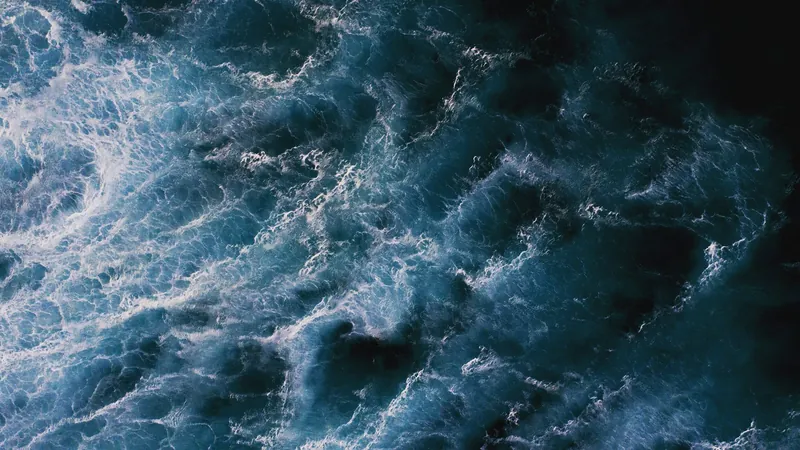
Is Uranus' Moon Miranda Hiding a Subsurface Ocean? Experts Weigh In!
2024-10-31
Author: Li
Recent research has sparked intrigue among scientists regarding Uranus' moon, Miranda. A fresh study indicates that this icy moon may well be concealing an ocean beneath its frozen exterior. This groundbreaking discovery could disrupt previous beliefs surrounding Miranda's geological evolution and composition, placing it within the elite group of solar system bodies thought to have potentially habitable environments.
Tom Nordheim, a planetary scientist from the Johns Hopkins Applied Physics Laboratory and co-author of the study, expressed astonishment at the findings. "To find evidence of an ocean inside such a small object as Miranda is incredibly surprising," he stated, emphasizing the exciting implications of such a discovery: "It suggests that there may be several ocean worlds around Uranus, which makes it an incredibly fascinating object of study."
Miranda, unlike any other moon in our solar system, is distinguished by its peculiar and varied terrain. The Voyager 2 spacecraft, which flew by in 1986, captured limited images showing Miranda's south pole—a landscape reminiscent of a patchwork quilt, exhibiting unusual grooved terrains, steep scarps, and craters. Most researchers theorize that these striking features resulted from tidal forces as well as internal heating.
Graduate student Caleb Strom and his team revisited the Voyager 2 data, aiming to decode Miranda's mysterious geology. They reconstructed the moon’s surface features and employed a computer model to explore various potential interior structures, ultimately linking the predicted stress patterns to the visible surface anomalies.
This research led to a surprising revelation: a subsurface ocean may have existed 100 to 500 million years ago, with depths possibly reaching up to 62 miles (100 kilometers) and hidden beneath a mere 19-mile-thick (30 kilometers) icy crust. Given that Miranda has a total radius of about 146 miles (235 kilometers), this ocean could account for nearly half of the moon's total volume. Strom referred to this finding as a "big surprise" for the team.
The team posited that these astonishing conditions were primarily influenced by tidal forces exerted by Miranda's neighboring moons. Such gravitational interactions can generate heat through friction, keeping celestial bodies warm despite their distances from the Sun. Notably, this phenomenon is illustrated by the close relationship between Jupiter's moons, Io and Europa, known to sustain subsurface oceans due to their resonant orbits.
As the moons likely experienced an intricate orbital dance, this heating process may have regulated Miranda’s internal temperatures and facilitated the maintenance of a subsurface ocean. However, at some point, their synchronized movements disrupted, causing a decline in heating and leading to the speculation that Miranda's interior has begun solidifying. Nevertheless, the absence of expected surface fractures suggests that there may still be a residual ocean below its icy crust.
What’s particularly tantalizing is the potential similarity between Miranda and Saturn's moon, Enceladus, which was once thought to be merely an icy shell until it was discovered to be geologically active, harboring an ocean and actively venting water vapor. Given that Miranda could be similarly active, it raises the question: could this remote moon also be a candidate for future astrobiological studies?
Research in 2023 has hinted at the possibility of Miranda influencing material ejection into space, echoing the conditions detected on Enceladus. Experts caution, however, that much remains to be understood about Miranda and the broader group of Uranian moons before making claims about the potential for life.
“We won’t know for certain until we gather more data,” insists Nordheim, as excitement builds within the scientific community for a possible future mission that could reveal even more about this enigmatic moon.
This captivating prospect reminds us that mysteries still abound out there in our solar system, and the potential for life may lurk in the cold vaults of ice-covered moons. Stay tuned as more revelations unfold!




 Brasil (PT)
Brasil (PT)
 Canada (EN)
Canada (EN)
 Chile (ES)
Chile (ES)
 España (ES)
España (ES)
 France (FR)
France (FR)
 Hong Kong (EN)
Hong Kong (EN)
 Italia (IT)
Italia (IT)
 日本 (JA)
日本 (JA)
 Magyarország (HU)
Magyarország (HU)
 Norge (NO)
Norge (NO)
 Polska (PL)
Polska (PL)
 Schweiz (DE)
Schweiz (DE)
 Singapore (EN)
Singapore (EN)
 Sverige (SV)
Sverige (SV)
 Suomi (FI)
Suomi (FI)
 Türkiye (TR)
Türkiye (TR)